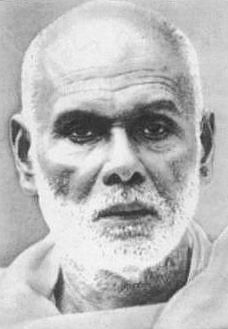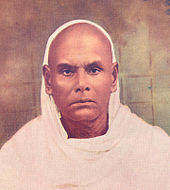This is an old revision of this page, as edited by AmritasyaPutra (talk | contribs) at 08:57, 4 September 2014 (→Family and early life: Add content with academic reference.). The present address (URL) is a permanent link to this revision, which may differ significantly from the current revision.
Revision as of 08:57, 4 September 2014 by AmritasyaPutra (talk | contribs) (→Family and early life: Add content with academic reference.)(diff) ← Previous revision | Latest revision (diff) | Newer revision → (diff)| Narayana Guru | |
|---|---|
 Narayana Guru Narayana Guru | |
| Personal life | |
| Born | 28th August 1855 Chempazhanthy, Travancore (now Kerala, India) |
| Died | 20 September 1928 Varkala, Travancore (now Kerala, India) |
| Religious life | |
| Philosophy | Vedic philosophy |
| Hindu saint, sadhu and social reformer of India | |
| This article is part of a series on |
| Reformation in Kerala |
|---|
 Narayana Guru, the most prominent face of the movement Narayana Guru, the most prominent face of the movement |
| Background |
| Notable people |
|
| Others |
Narayana Guru (ca. 1855–1928), also seen as Sree Narayana Guru Swami, was a Hindu saint, sadhu and social reformer of India. Guru was born in an Ezhava family, in an era when people from that community and other communities that were regarded as Avarna, faced much social injustice in the caste-ridden society of Kerala. Gurudevan, as he was known by his followers, led a reform movement in Kerala, rejected casteism and promoted new values of spiritual freedom and social equality.
He stressed the need for the spiritual and social upliftment of the downtrodden by their own efforts through the establishment of temples and educational institutions. In the process he denounced the superstitions that clouded the fundamental Hindu cultural convention of caste.
Biography

Family and early life
There are many legends surrounding the life of Narayana Guru but few certain facts until his rise to prominence in 1887. Guru was born with Chathayam star (Sathabhisha) on 28th August 1855, in the village of Chempazhanthy near Thiruvananthapuram, and it is generally accepted that he was educated at least in part by a Nair teacher from a nearby village. He appears in turn to have taught religion and Sanskrit to local children and also to have studied yoga with notable ascetics such as Chattampi Swami. He was an itinerant yogi for some time and Cyriac Pullapilly says that he was probably married for a few years but "his worshipful biographers ignored this part of his life out of reverence for his later ascetism".
In the course of his wanderings in search of enlightenment, Narayana visited Aruvippuram. There people sought his advice and powers of healing and he and his followers erected a temple to Shiva in 1887. He installed a small rock as an idol within that, defying the tradition that this was done by Brahmins. As a youth, Narayana Guru turned away from the temple rituals of his local village and traveled widely, living an ascetic lifestyle and seeking religious understanding. He eventually ecame a schoolteacher and then a religious reformer.
Narayana's literary and philosophical masterpiece is claimed to be Atmopadesa Satakam (one hundred verses of self-instruction), written in Malayalam around 1897.

In 1904,. Narayana settled at Sivagiri to pursue his Sadhana (spiritual practice). He chose Amba'as his deity and subsequently opened a Sanskrit school in Varkala. Poor boys and orphans were taken under his care. They were given education regardless of caste distinctions. Temples were built at different places – Thrissur, Kannur, Anchuthengu, Tellicherry, Calicut, Mangalore. A temple was built for Sharada Devi in 1912, at Sivagiri. Worship at such temples helped reduce to a large extent superstitious beliefs and practices.
In 1913, he founded the Advaita Ashram at Aluva, dedicating it to the principle of Om Sahodaryam Sarvatra (all men are equal in the eyes of God).
Narayana's 60th birthday was celebrated throughout the west coast from Mangalore to Sri Lanka. Between 1918 and 1923 he visited Sri Lanka many times. In 1921, a Conference of Universal Brotherhood was held at Aluva. Again in 1924, a conference of all religions was held there. He stressed the need for a Brahma Vidyalaya for a comparative study of different religious faiths.
Narayana had many followers and disciples. Nataraja Guru was one and was responsible for introducing his visions and ideals to the western world.
Sivagiri pilgrimage
| This section does not cite any sources. Please help improve this section by adding citations to reliable sources. Unsourced material may be challenged and removed. (August 2012) (Learn how and when to remove this message) |
The Sivagiri pilgrimage was conceived by Vallabhasseri Govindan Vaidyar and T K Kittan Writer. It was approved by Narayana on January 1928. Before giving its his blessings he set out the goals of such a pilgrimage.
He said that pilgrims could wear yellow clothes, being the colour of the garments that Buddha wore, and stated the goals of the pilgrimage to be the promotion of
- Education
- Cleanliness
- Devotion to God
- Organization
- Agriculture
- Trade
- Handicrafts
- Technical training
He advised Vaidyar and Writer to organise a series of lectures on the themes with experts conducting them. The lectures should be listened to attentively. More important, the principles should be put into practice. Success must accompany efforts. Only then will the country and the people benefit. this must be the core purpose of Sivagiri pilgrimage.

Finally, it was decided to start the first pilgrimage from the village of Elavumthitta in Pathanamthitta District. The S N D P unit No.76 of Elavumthitta selected five youngsters for the pilgrimage. All five pilgrims wore bright yellow dress. All the way to Sivagiri, they were reciting 'Swaathanthrya gadha' – written by the poet Kumaranaasan. The dominant thought in their mind was the mission to fulfil, will have to reach Sivagiri, a great responsibility bestowed on their shoulders by the Sreenarayana devotees. Their mission was a great success. Today thousands are following the way they have shown.
The Palluruthi event in 1927 was the last anniversary of the Yogam which Narayana attended and was also his last public function.
Narayana went to Vellur Mutt at Vaikom to rest. There he was taken ill. He went to Alwaye and later to Trichur for treatment. Dr. Krishnan took Gurudevan to Palghat. From there Gurudevan travelled to Madras for treatment.
Samadhi
Guru became seriously ill in September 1928. He remained bedridden for some time. Devotees came in large numbers to have a glimpse. The same year, Gurudevan's birthday was celebrated in many places, mostly in Kerala, Madras, Mangalore, Sri Lanka and Europe. On 20 September 1928, Guru attained Parinirvanam.
Public acceptance, honours and veneration
The International Center for Sree Narayana Guru Studies was established in 2005. Numerous other institutions, particularly those operated by the SNDP, are named after him.
Notable disciples
- Sree Bodhananda Swamikal
- Nataraja Guru
- Sade Guru Shivalingadasa Swamigal, born Kochapy Pilla in a nair family in Thiruvanathapuram, Kerala; the first direct saint disciple of Narayana Guru
Depictions
P.A. Backer directed a film titled Sree Narayana Guru in 1985, and in 2010 R. Sukumaran directed another film of the guru's life entitled Yugapurushan.
Gallery
Works
In Malayalam
- Swanubavageethi
- Atmopadesa Śatakam
- Advaitha Deepika
- Arivu
- Daiva Dasakam
- Jeevakarunya Panchakam
- Anukamba Dasakam
- Jathi Nirnayam
- Jathi Lakshanam
- Chijjada Chinthanam
- Daiva vichinthanam – 1 & 2
- Athma Vilasam
- Shiva Shathakam
- Kolatheereshastavam
- Bhadrakaalyashtakam
In Sanskrit
- Darsana Mala
- Brahmavidya Panchakam
- Nirvruthi Panchakam
- Slokathrayi
- Vedantha Suthram
- Homa Manthram
- Municharya Panchakam
- Asramam
- Dharmam
- Charama Slokangal
- Homa Mantram
- Chidambarashtakam
- Guhashtakam
- Bhadrakaliashtakam
- Vinayaka Ashtakam
- Sree Vasudeva Ashtakam
- 'Janani Navaratna Manjari "
Translations
- Thirukural
- Isavasyo Upanishad
- Ozhivil Odukkam
See also
- Sree Narayana Dharma Sangham
- Temples built by Narayana Guru
- M. C. Joseph
- C. V. Kunhiraman
- Mithavaadi Krishnan
- Daiva Dasakam
- List of Shudra Hindu saints
Notes
- Smith, Bardwell L. (1976). Religion and social conflict in South Asia. International studies in sociology and social anthropology. Vol. 22. BRILL. pp. 35–39. ISBN 978-90-04-04510-1.
- Smith, Cyriac K. (1976). "The Izhavas of Kerala and Their Historic Struggle for Acceptance in the Hindu Society". Religion and Social Conflict in South Asia. Leiden: BRILL. pp. 35–36. ISBN 9789004045101.
{{cite book}}:|editor-first=missing|editor-last=(help) - Younger 2002, p. 127.
- "Sri Narayana Guru: A short biography – Chronology of Events". Retrieved 18 May 2013.
- "Chapter XI : The Last Days of A Great Life – THE BIOGRAPHY OF SREE NARAYANA GURU". Retrieved 18 May 2013.
- "International Centre for Sree Narayana Guru Studies". Sree Narayana Mandira Samiti. Retrieved 23 December 2011.
References
Books
- Younger, Paul (2002). Playing host to deity : festival religion in the South Indian tradition. New York: Oxford University Press. ISBN 0-19-514044-3.
{{cite book}}: Invalid|ref=harv(help) - Dre`ze, Jean (1997). Indian development : selected regional perspectives (in Dutch). Delhi New York: Oxford Univ. Press. ISBN 0-19-829204-X.
{{cite book}}: Invalid|ref=harv(help)
Further reading
- Sree Narayana Guruswamikalude jeeva charithram– Moorkothu Kumaran-(The official biography as approved by Sivagiri mutt.) Published by SNDS Trust
- Sree Narayana Gurudeva Krithikal – Sampoorna Vyakyanam – G Balakrishnan Nair- (Works of Sree Narayana Guru with Complete Interpretations – ten parts compiled in two volumes) published by The State Institute of Languages, Kerala.
- The Word of the Guru : The Life and Teaching of Guru Narayana : Nataraja Guru, D.K. Printworld, 2003, New Delhi, ISBN 81-246-0241-7
- Guru – Kumaranasante Drushtiyil : DC Books, Kottayam, Kerala
- Srinarayana Guruvinte Sampoorna Kruthikal (Complete Works of Sri Narayana Guru): Mathrubhoomi Publishers, Kozhikode, Kerala
- Sri Narayana Guruvinte Mathavum Sivagiriyum (Sivagiri and the Religion of Sri Narayana Guru): K. Maheshwaran Nair
- Sri Narayana Guru – Jeevitham, Darsanum, Kruthikal: Editor: K.N.Shaji, Current Books, Trissur, Kerala
- Narayanaguru- Editor: P.K.Balakrishnan (A collection of essays in Malayalam):March 2000, (First Edition 1954), Kerala Sahitya Academi, Trichur, Kerala.
- The Philosophy of Narayana Guru: Swami Muni Narayana Prasad, D.K. Printworld, 2003, New Delhi, ISBN 81-246-0236-0.
- Yukthirekha August 2004 (Special issue commemorating the 150th Birth Anniversary of Sri Narayana Guru) – Dhanuvachapuram Post, Trivandrum-695503, Kerala.
External links
[REDACTED] Media related to Narayana Guru at Wikimedia Commons
Categories:



